View in other NatureServe Network Field Guides
NatureServe
Montana
Utah
Wyoming
Idaho
Wisconsin
British Columbia
South Carolina
Yukon
California
New York
Cascade reedgrass - Calamagrostis tweedyi
State Rank Reason (see State Rank above)
A species of limited distribution and currently considered to be globally rare. Restricted in Montana to the extreme western portion of the state.
General Description
Cascade Reedgrass is a glabrous perennial arising from a short rhizome with flowering stems which stand 4-15 dm tall. The blades of the stem leaves are flat, 5-13 mm wide, and up to about 12 cm long; leaves from short vegetative shoots have somewhat narrower and longer blades (up to 30 cm). The leaves have open sheaths and membranous ligules, which are 6-15 mm long, but no auricles. Numerous spikelets are borne in a compact panicle which is 8-16 cm long and about 2 cm wide. The spikelets consist of 2 glumes which enclose a single floret. The glumes are approximately equal in size, 4.5-9 mm long, and slightly longer than the lemma. A sharply bent awn arises from around the middle of the lemma back and exceeds the glumes by about 5 mm. The callus is slightly bearded with hairs less than 1 mm long.
Phenology
Fruiting in July.
Diagnostic Characteristics
Distinguished from other Calamagrosis in Montana by the combination of having flat leaves, a long bent awn, and an only slightly bearded callus. Vegetative plants of the species may be identified by the leaf and habit characters given above, but closely resemble Cinna latifolia, which grows along with the species in Montana.
Species Range
Montana Range
Range Descriptions
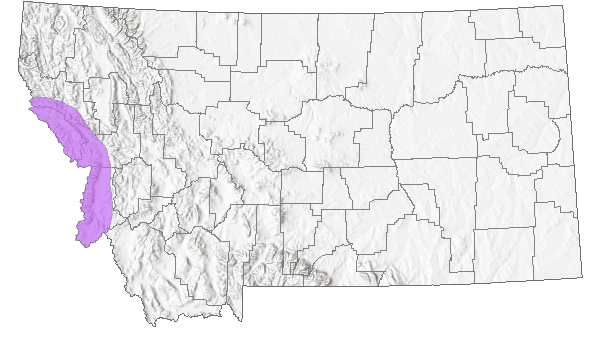
 Native
Native
Range Comments
Collected in Mineral and Ravalli counties; WA, ID and MT (Lavin in Lesica et al. 2012. Manual of Montana Vascular Plants. BRIT Press. Fort Worth, TX).
Observations in Montana Natural Heritage Program Database
Number of Observations: 35
(Click on the following maps and charts to see full sized version)
Map Help and Descriptions
Relative Density
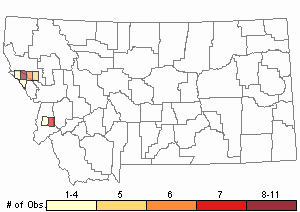
Recency
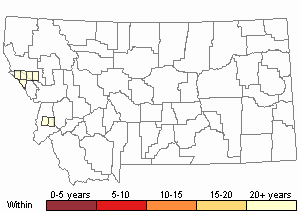

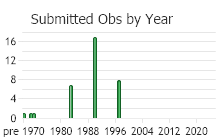
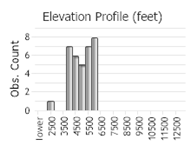 (Observations spanning multiple months or years are excluded from time charts)
(Observations spanning multiple months or years are excluded from time charts)
Habitat
Seral stages of Douglas-fir and subalpine fir forests in the montane zone.
National Vegetation Classification System Groups Associated with this Species
Forest and Woodland
Montane - Subalpine Forest and Woodland
Grassland
Montane - Subalpine Grassland
Recently Disturbed or Modified
Harvested Forest
Recently Burned
Stewardship Responsibility
Threats or Limiting Factors
STATE THREAT SCORE REASON
Threat impact not assigned because threats are not known (MTNHP Threat Assessment 2021).
References
- Literature Cited AboveLegend:
 View Online Publication
View Online Publication Lesica, P., M.T. Lavin, and P.F. Stickney. 2012. Manual of Montana Vascular Plants. Fort Worth, TX: BRIT Press. viii + 771 p.
Lesica, P., M.T. Lavin, and P.F. Stickney. 2012. Manual of Montana Vascular Plants. Fort Worth, TX: BRIT Press. viii + 771 p. MTNHP Threat Assessment. 2021. State Threat Score Assignment and Assessment of Reported Threats from 2006 to 2021 for State-listed Vascular Plants. Botany Program, Montana Natural Heritage Program, Helena, Montana.
MTNHP Threat Assessment. 2021. State Threat Score Assignment and Assessment of Reported Threats from 2006 to 2021 for State-listed Vascular Plants. Botany Program, Montana Natural Heritage Program, Helena, Montana.
- Additional ReferencesLegend:
 View Online Publication
View Online Publication
Do you know of a citation we're missing? Lesica, P., M.T. Lavin, and P.F. Stickney. 2022. Manual of Montana Vascular Plants, Second Edition. Fort Worth, TX: BRIT Press. viii + 779 p.
Lesica, P., M.T. Lavin, and P.F. Stickney. 2022. Manual of Montana Vascular Plants, Second Edition. Fort Worth, TX: BRIT Press. viii + 779 p.
- Web Search Engines for Articles on "Cascade reedgrass"





